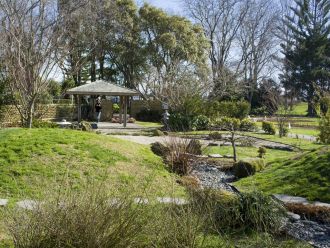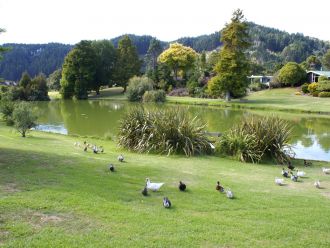Whakatāne is home to a number of beautiful gardens. They’re all close to town and offer a perfect place for a sunny weekend walk.

Whakatāne Gardens
The Gardens are situated between McGarvey Road and McAlister Street. A formal entrance gives way to rose gardens, a scented garden and areas of bulbs, shrubs and perennials. In February 2003, Whakatāne's Sister City in Japan, Kamagaya, contributed to the construction of a small Japanese garden. An amphitheatre is used as a venue for plays and concerts during the summer cultural events.
Awatapu Lagoon
Awatapu Lagoon was formed when an ox-bow of the Whakatāne River was isolated as part of a major scheme by the Bay of Plenty Catchment Commission in 1970. Plantings have been carried out over the years, and the area is now lush and green. The dog exercise area is a perfect place to chase a ball.

Sullivan Lake Park
Once part of the Whakatāne River system, this site was developed in 1967 from a swampy lagoon into a five hectare reserve and lake. It is now a beautiful and peaceful area visited by many individuals and groups. The lake is home to much birdlife and is the perfect place to take children to feed the ducks.
Note: Cyanobacteria may be present in Awatapu Lagoon and Sullivan Lake all year round, especially during the warmer summer periods, and can form dark-coloured floating algae. Do not drink the water, and ensure humans and pets do not come into contact with this organic toxin.
More information is available via Toi Te Ora Public Health Service.
Waiewe Camellia Park
Whakatāne is a premiere camellia growing area; this park highlights these colourful flowering shrubs and their cousins, the spectacular Michaelias. Shake off the winter blues with the blaze of colour in this small quiet park.
River Edge Park
A rich and diverse riverside park, offering walking tracks, a skatepark and the Ocean Playground. River Edge Park also hosts the Riverside Amphitheatre and a model railway that opens periodically in the school holidays.
Otuawhaki and The Promenade
Originally part of the first waterfront development of the town in the earliest European settlement era, this is a strip of riverbank extending from the main wharf at its eastern end, to the Yacht Club at the western end.
The Whakatāne Visitor Information Centre is situated in a prime position overlooking both the river and the main business area. The Promenade is lined with seats and picnic tables that are popular with both locals and visitors. The Promenade also provides direct access to the Otuawhaki Wharf.
Wairaka Park
This park, from the main boat ramp to opposite the signal station, was officially opened in 1940 as the District's celebration of the signing of the Treaty of Waitangi. Its full name is the Wairaka Centennial Memorial Park.
The central area of the park is a family area that many enjoy. It has a grassed area with seats and pohutukawa trees, and a small beach and swimming area separated from the main river by a rock wall. You can sit and relax in the sun, enjoying the views of Kohi Point, the Piripai Spit, Whale Island and the Whakatāne River.
The activities of the fishing and sightseeing boats travelling in and out over the Whakatāne bar make enjoyable watching, and at night the lights of Whakatāne are reflected on the water.
Scenic Reserves
Close to Whakatāne township are two bush reserves that each have popular walking tracks. The regenerating bush is thriving as a result of intensive possum and rat control. Native bird numbers are on the increase, and these reserves offer you the chance to hear wild kiwi calling as they emerge from their burrows for a night's foraging.

Kohi Point Scenic Reserve
This reserve adjoins the Kaputerangi Historic Reserve and comprises 154 hectares of native bush extending from the ridge above the Whakatāne Heads, across the valley to Otarawairere, and along the coast to the west end of Ōhope Beach. A major walking track, Ngā Tapuwae o Toi, leads from Whakatāne to Otarawairere Bay and West End.
Mokorua Bush Scenic Reserve
Comprising about 325 hectares of regenerating native bush, this reserve offers a well-established walkway, the Whakatāne Birdwalk. In 2009, the first kiwi were released into Mokorua Bush Scenic Reserve. They have joined other birds that have wandered into the reserve from the nearby Ōhope Scenic Reserve. The best time to hear kiwi calling is in the first two hours after sunset.